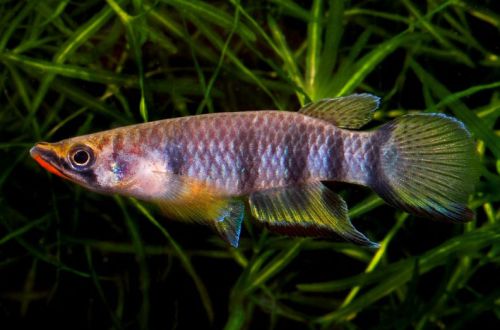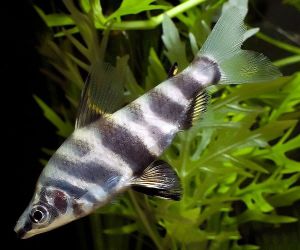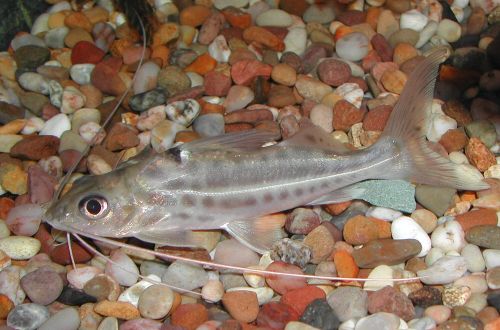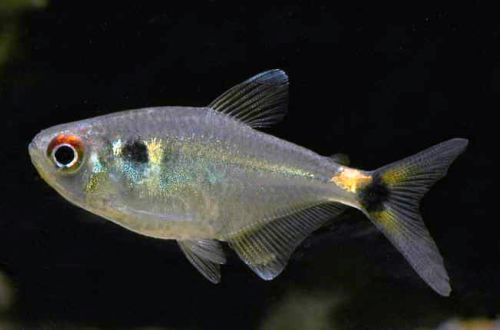
Black-mouthed Panhax
Epiplatis Dageta or Blackmouth Panhax, scientific name Epiplatys dageti, belongs to the Nothobranchiidae family. Peaceful beautiful fish, perfect for the general aquarium. Moderately hardy and unpretentious, it can be recommended for beginner aquarists. Males have a characteristic feature of this species – the red color of the lower surface of the mouth, bordered by a black stripe.

Contents
Habitat
Representative of the African continent from the legendary Ivory Coast region. It lives in wetlands of the coastal savannah, including brackish waters, on the territory of modern Côte d’Ivoire, Liberia, Ghana.
Description
Small fish, adults reach only 4.5 cm in length, and males are somewhat larger, more colorful and have extended large fins. On the lower jaw they have a red mark, bordered by a dark stripe. In the body pattern there are wide dark stripes, the main color is pink.
Food
A carnivorous species, in nature it feeds on terrestrial and aquatic invertebrates and other zooplankton. The home aquarium will accept dried or frozen/live meat products of a suitable size such as daphnia, bloodworms, brine shrimp, etc.
It is allowed to serve mosquitoes, Drosophila flies, however, dry flakes with plant components should first be served for better digestion, otherwise there is a high probability of constipation.
Maintenance and care
Recreating a natural biotope in a home aquarium is the best design option and includes some roots, tree branches, snags, and areas of rooting and floating plants. The substrate is sandy with the addition of dry leaves, which bring with them the humic substances natural for the Blackmouth Panhax, which are formed during the decomposition process.
The set of equipment consists of a lighting system set to low light, a heater, an aerator and a filter. The latter is installed in such a way that there is any obstacle in the way of the outgoing water flows, due to which the internal flow is weakened. Fish are sensitive to water movement, preferring stagnant water.
The pH and dGH are in the slightly acidic and mild ranges, respectively. When filling the aquarium and then renewing part of the water, these parameters should be artificially adjusted, since tap water does not match them. Read more about pH and dGH in the “Water chemistry” section.
Aquarium maintenance comes down to weekly replacement of part of the water with fresh water (10-15% of the volume), periodic cleaning of the soil from organic waste and removal of plaque from the glass with a scraper as necessary.
Behavior and Compatibility
Peaceful calm species, great for a community aquarium with some representatives of characins, cyprinids, Killy fish and other species of similar size and temperament. The content is schooling from 6 individuals, there is no intraspecific competition, males are friendly to each other even during the spawning period.
Breeding / breeding
The mating season occurs regularly, spawning is possible even in a common aquarium, but the survival rate of the offspring will be very low. Parents and other species pose a threat to fry, and it is difficult to achieve sufficient nutrition in a large tank.
Good results are achieved in a separate spawning aquarium, which is decorated with a large number of plants like Riccia and Java moss. The equipment consists of a simple sponge filter, a heater, and a light fixture with a low power lamp. The water composition should be completely identical to the water in the general aquarium.
When the female becomes noticeably rounded, and the male begins to show a brighter color and pay persistent attention to the opposite sex, then the mating season has begun. The female and one or two males are placed in a spawning aquarium, and the female is placed there a day earlier for adaptation. After some time, the female lays her eggs in the thickets of plants, and the male / males fertilize her. Then the parents are sent back.
Eggs develop for 11–14 days at 21–23°C, in a similar range there is an even distribution of both sexes, and if the temperature is higher, more males than females will appear. Feed microorganisms of the species Artemia nauplii or shoe ciliates.
Fish diseases
The Black Mouth Panhax is very successfully adapted to the conditions of the home aquarium and is distinguished by good endurance and unpretentiousness. A balanced aquarium with the right conditions ensures that your pets do not have health problems. Deteriorating water quality, poor nutrition, or otherwise greatly increase the risk of disease. Therefore, before making a decision on treatment, make sure that the conditions are as recommended for the species. Read more about symptoms and treatments in the Aquarium Fish Diseases section.





